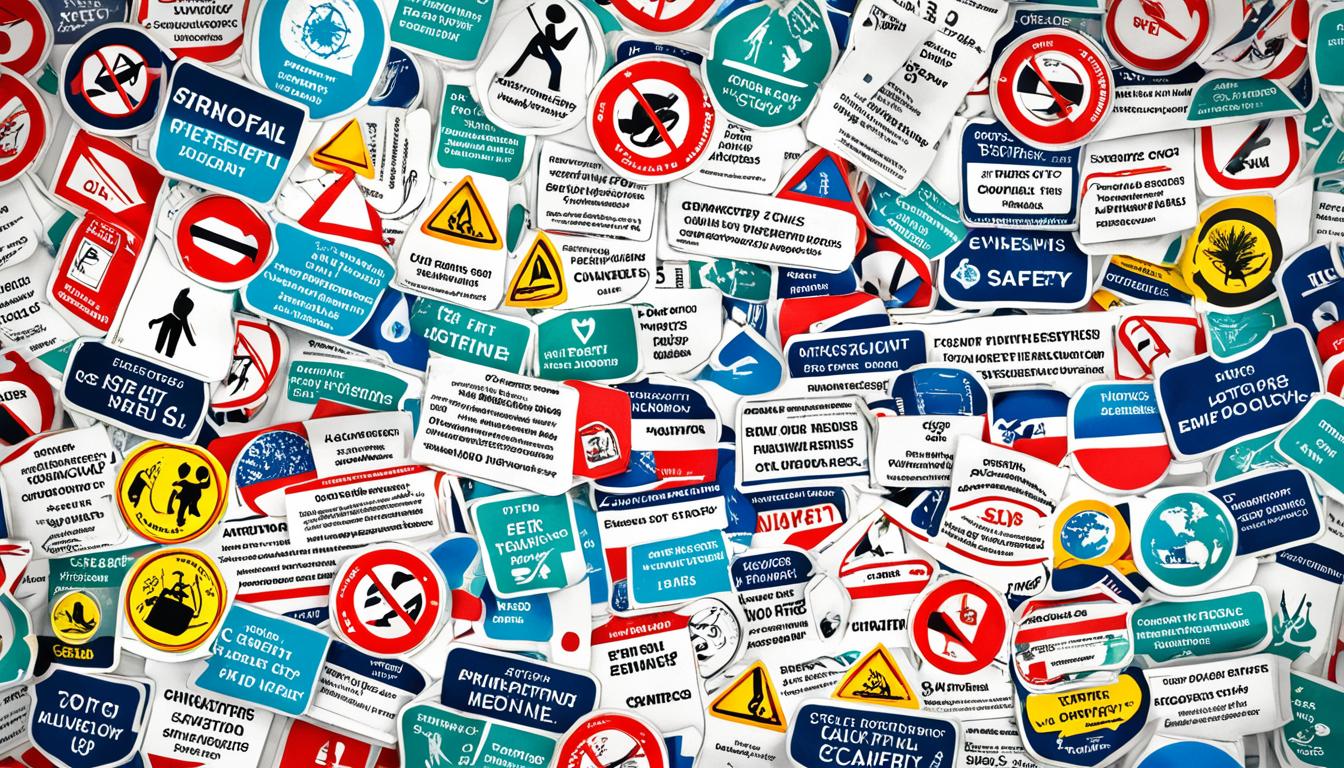Disclosure: This Post Contains Affiliate Links; We earn a commission on purchases.
Welcome to our comprehensive analysis of international EMF safety protocols. In this article, we will delve into the various guidelines, standards, and regulations established by different countries and organizations to ensure the safety of individuals in relation to electromagnetic fields (EMF). The topic of EMF safety has gained significant attention in recent years, as the widespread use of technology increases our exposure to EMF.
EMF guidelines and electromagnetic field safety standards are crucial for protecting public health and maintaining radiation safety regulations worldwide. With the advancement of global technology, it is essential to have robust and effective measures in place to address potential risks associated with EMF exposure. Therefore, understanding and comparing international EMF safety protocols is of paramount importance.
To provide accurate and reliable information, our research is based on multiple sources, including governmental websites, scientific publications, and policy summaries. We have conducted an extensive analysis to present you with a comprehensive overview of the various international policies on EMF and the exposure of the general public to power frequency and radiofrequency fields.
Key Takeaways:
- International EMF safety protocols play a critical role in protecting individuals from the potential risks associated with electromagnetic fields.
- Guidelines and standards for EMF safety vary among different countries and organizations.
- Power frequency and radiofrequency fields are regulated by international policies derived from recommendations and guidelines provided by organizations such as the Council of the European Union, ICNIRP, and IEEE.
- The exposure of the general public to power frequency fields is governed by various policies and regulations, including precautionary measures near areas where children are present.
- Different countries and regions have established their own reference levels for RF-EMF exposure, some being more stringent than international standards.
With this comparative analysis, we aim to provide you with valuable insights into international EMF safety protocols. Stay informed and take proactive measures to protect yourself and your loved ones from potential risks associated with EMF exposure.
Overview of International Policies on Electromagnetic Fields
When it comes to regulating the exposure to electromagnetic fields (EMF), there are comprehensive international policies in place. These policies are derived from recommendations and guidelines provided by renowned organizations such as the Council of the European Union, the International Commission on Non-Ionizing Radiation Protection (ICNIRP), and the Institute of Electrical and Electronics Engineers (IEEE).
These international policies encompass both power frequency and radiofrequency fields, which are known to have potential health implications. To ensure the safety of individuals, these policies include basic restrictions for induced electric fields, reference levels for EMF strength, and exposure limit values.
It is worth noting that different countries and regions have adopted their own limits based on these international standards. While some jurisdictions adhere strictly to the guidelines, others have more lenient protocols. This variation in guidelines reflects the differing interpretations and risk assessments conducted across different regions.
To provide a visual representation of the variations in EMF exposure protocols, here is a comparative table showcasing some key international standards:
| Country/Region | Power Frequency Fields | Radiofrequency Fields |
|---|---|---|
| European Union | EU recommendation on EMF exposure limits | EU guidelines on RF-EMF exposure |
| United States | Federal Communications Commission (FCC) limits | IEEE guidelines |
| Canada | Health Canada limits | Health Canada guidelines |
As you can see, there are variations in how individual countries and regions have implemented these international standards. It is important for governments and regulatory bodies to continuously evaluate and update their protocols based on emerging research and technological advancements.
“The safety of individuals in relation to electromagnetic fields is a global concern. International policies and guidelines play a crucial role in ensuring a standardized approach to EMF exposure throughout the world.” – ICNIRP
By adhering to international EMF safety protocols, countries can prioritize the well-being of their citizens while fostering technological advancements. It is a delicate balance that requires ongoing research and collaboration between policymakers, scientists, and industry experts.
The Role of National Regulations
While international standards provide a baseline for EMF exposure limits, individual countries have the flexibility to establish their own protocols based on these standards. This allows countries to address specific concerns and tailor their guidelines to their unique socio-economic and technological landscapes.
For example, certain countries may have more stringent guidelines than the international standards to provide an added layer of protection for their population. On the other hand, some countries may adopt precautionary principles, implementing policies that go beyond the formal legislation to minimize exposure in sensitive areas such as schools and hospitals.
It is essential for nations to strike a balance between technological advancements and the health and safety of their citizens. By continuously reviewing and updating their EMF exposure protocols, countries can ensure that their population is protected from potential risks.
Exposure of the General Public to Power Frequency Fields
The exposure of the general public to power frequency fields is governed by various policies and regulations. According to the first source, countries within the European Union (EU) follow different approaches in addressing this issue. Some countries have binding national legislation that incorporates the EU’s recommendation on EMF exposure limits. Alternatively, there are countries that may have more lenient limits or even no regulation at all, but still apply the EU recommendation in practice.
Furthermore, several countries have implemented precautionary policies specifically aimed at minimizing exposure to power frequency magnetic fields, particularly in areas where children are present. These policies are implemented to supplement formal legislation and ensure extra protection for vulnerable populations. They reflect a commitment to reducing potential health risks associated with prolonged exposure to power frequency fields.
“Our priority is to protect public health and ensure the well-being of our citizens. By implementing precautionary policies, we aim to provide an additional layer of protection against potential harm caused by power frequency fields.”
Despite variations in policies and approaches, the usage of reference levels remains crucial in assessing and addressing power frequency field exposure. Reference levels are established based on scientific research and international standards, encompassing measurements that help establish safe exposure limits.
| Country | Binding National Legislation | Precautionary Policies |
|---|---|---|
| Country A | Yes | No |
| Country B | Yes | Yes |
| Country C | No | No |
Table: Policies on Power Frequency Field Exposure by Country
The table above provides an overview of different countries’ policies regarding power frequency field exposure. It highlights the presence of binding national legislation and the implementation of precautionary policies in each country. The diverse approaches demonstrate the complexities involved in regulating power frequency field exposure and striving for public safety.
As the understanding of power frequency fields continues to evolve, it remains essential to develop and enforce policies that protect the general public from potential risks. By incorporating evidence-based research and international standards, policymakers can establish robust frameworks that prioritize the well-being of individuals in today’s technologically advanced world.

Limits of Human Exposure to Radiofrequency Electromagnetic Fields (RF-EMF)
In this section, we will delve into the crucial aspect of setting limits on human exposure to radiofrequency electromagnetic fields (RF-EMF). As we have previously discussed, RF-EMF is a significant concern due to its potential impact on human health. Various countries and regions globally have established their specific reference levels for RF-EMF exposure based on international standards set by notable organizations such as the International Commission on Non-Ionizing Radiation Protection (ICNIRP), the Institute of Electrical and Electronics Engineers (IEEE), and national regulatory bodies like the Federal Communications Commission (FCC) in the United States.
It’s important to note that these reference levels may vary depending on the country or region, highlighting the diversity in approaches to RF-EMF regulation. Some countries, including Canada, Italy, and certain regions of Belgium, have adopted lower limits for RF-EMF exposure compared to the international standards. This reflects a precautionary approach to ensure enhanced protection for individuals.
However, it is crucial to continue researching and evaluating the adequacy of the current RF-EMF exposure limits. Ongoing research will help determine the need for worldwide reference limits, considering emerging technologies and potential health effects. Striking the balance between technological advancement and safeguarding human well-being remains a priority in the development and revision of international standards.

| Country/Region | RF-EMF Reference Levels (International Standards) | RF-EMF Reference Levels (Country/Region) |
|---|---|---|
| Canada | ICNIRP, IEEE | Lower limits compared to international standards |
| Italy | ICNIRP, IEEE | Lower limits compared to international standards |
| Belgium (specific regions) | ICNIRP, IEEE | Lower limits compared to international standards |
| Other countries | ICNIRP, IEEE | Variations in reference levels |
Conclusion
In conclusion, this comparative analysis highlights the importance of International EMF Safety Protocols in safeguarding individuals from potential risks associated with electromagnetic fields. Through a thorough examination of various countries and organizations, we have observed distinct variations in the establishment of limits, reference levels, and basic restrictions.
It is crucial for countries to continuously evaluate and update their policies based on scientific research to ensure the ongoing protection of public health in an era of evolving technology and increased exposure to EMF. By adhering to global health standards and incorporating the principles of the precautionary approach, governments can effectively mitigate potential health risks.
As technology continues to advance, it is essential to maintain a collaborative approach to global EMF protection. This requires ongoing research, knowledge sharing, and harmonization of guidelines across countries and regions. By working together, we can create a safer environment for individuals, ensuring that the benefits of technology are balanced with the need to protect human health.
Source Links
- https://pubmed.ncbi.nlm.nih.gov/38199478/
- https://pubmed.ncbi.nlm.nih.gov/17495666/
- https://www.rivm.nl/sites/default/files/2018-11/Comparison of international policies on electromagnetic fields 2018.pdf

Subscribe to Our Newsletter









